| |
|
|
|
|
| |
An International Flashpoint |
|
|
|
| |
|
|
|
|
| |
Abuse of Aboriginal Title & Rights |
|
Wilderness: Awe vs Annihilation |
|
| |
Corrupt Politics: the Downward Spiral |
|
The Struggle of Environmentalism |
|
| |
Corporate Greed: Stump to Dump |
|
A Brave Stand: Betty! |
|
| |
|
|
|
|
| |
|
|
| |
|
|
|
|
| |
A Brave Stand: Betty!
Betty Shiver Krawczyk (b. 1928) is the foremost defender of old growth forests in Canada. Since her 70th birthday, Betty has been repeatedly arrested for her courageous defence of the big trees of British Columbia (BC). Her motivation is to protect forest biodiversity, to save public forests from privatization and to create community managed forests and jobs. To protest against rapacious industrial plunder and devious government complicity, Betty has engaged in numerous frontline blockades. In May 2003, outraged over the commercial wrecking of Vancouver Island's last old growth remnant by Weyerhaeuser, Betty set up a blockade on a remote logging road in the Upper Walbran Valley. This she bravely held for three weeks until the Royal Canadian Mounted Police arrested and forcibly removed her (right). |
|
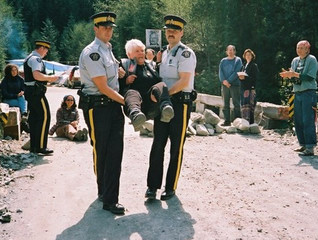
Betty forcibly removed, 8 May 2003.
Photo: Ingmar Lee |
|
| |
|
|
|
|
| |

|
Corporate Logging – Stolen Land – Stolen Trees – Stolen Future
Blockade by the Women in the Woods, Upper Walbran Valley, Vancouver Island, 2003 |
| |
| |
|
|
|
|
| |

Tolkien Giant, Upper Walbran Valley, 2007.
Photo: Wilderness Committee
Betty demands that the BC Court "Lock me up or let me go" and she is prepared to sacrifice her freedom for incarceration in order to defend the forests from plunder (right). "Why should giant logging companies, including and especially foreign ones like Weyerhaeuser, come into our public forests, strip them bare, clearcutting, leaving trashed land and communities behind? This is outrageous! These forests are PUBLIC, they belong to the people and to the First Nations peoples of BC and it is time that we reclaim them."
Many environmentalists have been inspired by Betty, including Wilderness Committee leaders Paul George, Joe Foy and Ken Wu who share Betty's goal to stop the insane annihilation of BC's surviving big trees. When two of the widest trees in Canada were discovered in 2006 in the Upper Walbran Valley, they launched a campaign to force the government to ban old growth logging. In 2010 the campaign was reinvigorated by the Ancient Forest Alliance. |
|
Among the BC big trees that need protection is the "Tolkien Giant," an ancient cedar measures 4.76 m (15.7 ft) in diameter (left). Ken Wu, who is pictured beside this unique and magnificent tree in the Upper Walbran, reminds the public: "We're so incredibly fortunate here in BC to have these gargantuan sized old growth trees still growing in wilderness ecosystems." The senseless killing of these last big trees in the new millenium is an ecological crime that has yet to be exposed.
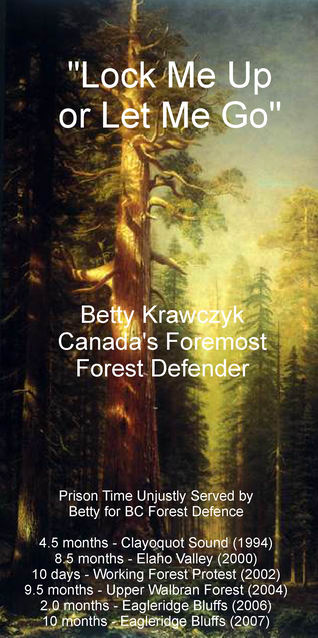
Tolkien Giant, Upper Walbran Valley, 2007.
Photo: Wilderness Committee |
|
| |
|
|
 |
|
| |
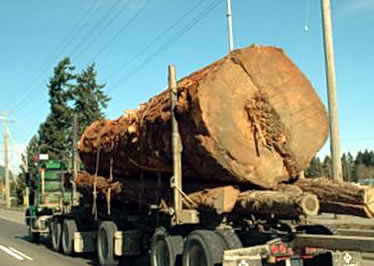 |
|
Right: Instead of being vilified for his criminal acts of nature destruction, the owner of Hayes Forest Services sits on the Royal BC Museum board of directors (2008).
Left: Hayes Forest Services logging truck with an ancient fir, c. 800 years old. This "snapshot" by Bonnie Hayward of Youbou Timber Less Society was taken 5 April 2006. |
 |
|
|
| |
|
|
|
|
| |
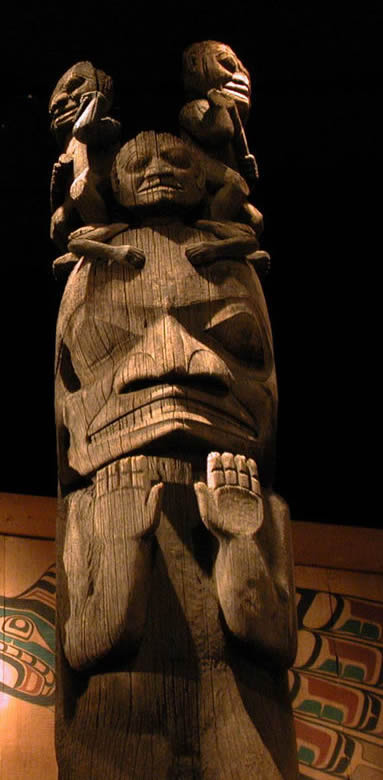
Totem pole, Royal BC Museum, 2007.
Photo: Craig Zone |
|
During Betty's 2003 blockade in the Upper Walbran, young forest activists were attacked with impunity by pro logging thugs. While the cutblock licence belonged to Weyerhaeuser, the contractor was Hayes Forest Service, a company based in Duncan, the "City of Totems," on Vancouver Island. Owned by Don Hayes, for three generations the company has profited from the destruction of the once grand primaeval forests.
Notwithstanding his record of eco vandalism, Hayes is a director of the Royal BC Museum, a public education institution with one of the world's most spectacular collections of Northwest Coast carving including magnificent totem pole masterworks (left and below).
Totem poles are a Northwest Coast monumental art form created from selectively harvested cedar trees and forests that were sustainably managed by the aboriginal peoples for millenia before colonisation and industrial logging. With the extermination of these totem pole trees, aboriginal heritage is also being extinguished. This is a case of indigenous rights abuse of international purport. Ominously, Hayes is a founding director in 2004 of the deceitfully named "New Relationship Trust," another slick government gimmick designed to conceal its business as usual pro industry strategy.
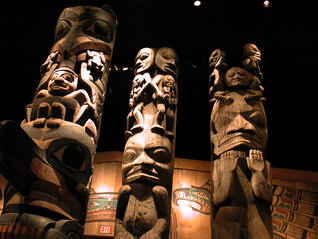
Totem pole, Royal BC Museum, 2007.
Photo: Craig Zone |
|
| |
|
|
 |
|
| |

Betty served with injunction, 8 May 2003.
Photo: Ingmar Lee |
|
| |
|
|
|
|
| |

Betty served with injunction, 8 May 2003.
Photo: Ingmar Lee |
|
During her arrest on a logging road in the Upper Walbran Forest in 2003 (above and left), Betty was served an injunction which had been obtained from the government by Hayes Forest Service, a sub contracter for Weyerhaeuser. By contrast, the Royal Canadian Mounted Police took no action in 1998 when 15 employees of Hayes Forest Service and TimberWest attacked and victimized six forest activists who had set up a logging blockade in the Walbran. |
|
| |
|
|
|
|
| |
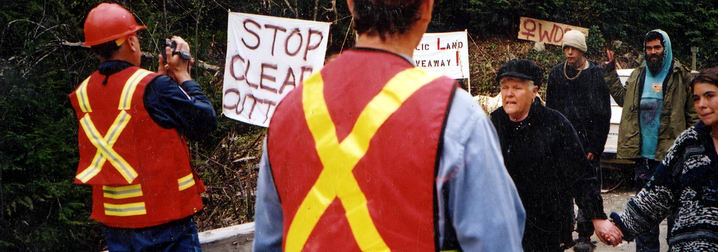
Betty served with injunction, 8 May 2003.
Photo: Ingmar Lee |
|
| |
|
|
|
|
| |
Just before Christmas in 2006, Hayes Forest Service served Betty with a legal suit for damages caused by her Walbran logging road blockade in 2003. Hayes is also pursuing a permanent legal injunction against the penniless great grandmother forest activist so that she will be instantly thrown into jail, without due process, if she ever again dares to blockade a Hayes logging truck in the Walbran.
Such corporate displays of power over publicly owned forest land reveal endemic corruption. Hayes is part of a tangled consortium of forest destruction companies such as Western Forest Products, TimberWest, Island Timberlands, Brookfield, Weyerhaeuser, MacMillan Bloedel, Teal Jones, etc. The big tree victims of this dark consortium must number in the thousands — an unconscionable eco crime that goes not unnoticed yet without punishment.

"Big Betty," Upper Walbran Forest, 2003.
Photo: Ingmar Lee |
|

Measuring a giant in the Upper Walbran, 2003.
Photo: Wilderness Committee
Unbelievably, Don Hayes continued to target and kill the last surviving big trees on Vancouver Island until his rotten company went bankrupt in 2008. While Hayes has profitted by his quasi legal acts of despoilation on the behalf of transnational lumber corporations and gained social prestige, Betty has languished in prison for long periods, outcast by the BC Court and its punative judges.
Not far from Betty's 2003 Walbran blockade stands the endangered "Big Betty" (left), a record Douglas fir named in honour of the veteran forest activist.
|
|
| |
|
|
 |
|
| |

Betty served with injunction, 8 May 2003.
Photo: Ingmar Lee |
|
| |
|
|
|
|
| |
Right: To call attention to the skyrocketing export of raw logs from BC to the US and Asia, on 22 March 2005 Betty initiated a blockade with her activist group "Women in the Woods" at the Fraser Surrey Docks where she succeeded in stopping the commercial traffic for almost an hour. Official figures confirmed that BC had exported 14 million cubic metres of logs during the past four years, a figure that compares with five million cubic metres during the previous four years. Wilderness Committee leader Joe Foy said "We think that people who do this in a peaceful manner for a cause like this are heroes." Foy advises the government to immediately prohibit the export of all raw logs taken from Crown land in BC and to restrict those taken from private lands in order to slow down the flood from the province to the US and Asia, an unsustainable situation that will have a drastic long term economic effect on the industry. |
|

Raw log protest, 22 March 2005.
Photo: Stuart Davis |
|
| |
|
|
 |
|
| |

Betty Krawzyck, Eagleridge Bluffs, 24 April 2006.
North Vancouver, British Columbia |
|

Banner: "Support a Green Olympics."
Eagleridge Bluffs, North Vancouver
The efforts by the Eagleridge Bluffs Coalition to stop the destruction exposed the dark underside of the 2010 Vancouver Olympics which fuels a real estate bonanza. Greenwash and promises of sustainable development are intended to cover up the enormous costs in terms of nature destruction, as the "Sea to Sky Highway" is expanded and new subdivisions and golf courses are opened up by greedy speculators. Paying the price are First Nations whose unceded land is yet again being illegally grabbed and also the wildlife inhabitants whose homes are destroyed. |
|
| |
|
|
|
|
| |
 |
|
Left: Petition calling for a public inquiry into the sentencing of Harriet Nahanee (Click for pdf). The petition demanded that BC Attorney General Wally Oppal and BC Premier Gordon Campbell launch an immediate investigation: "We, the undersigned, condemn BC Supreme Court Justice Brenda Brown's handling of contempt of court charges against 71 year old native Elder Harriet Nahanee, which resulted in a 14 day jail sentence on January 24, 2007. Respected Elder Nahanee filed an appeal, but died shortly after being released from Surrey Pre Trial Services Centre." |
|
| |
|
|
 |
|
| |
Harriet Nahanee Betty Shiver Krawczyk is well known for her efforts to save the ancient forests of BC by means of courageous acts of civil disobedience that include road blockades, a nonviolent form of frontline environmental activism. She has received less attention for her support of First Nations, the indigenous peoples of the Northwest Coast who ever since colonization have borne the brunt of the environment wrecking policies of various invading white governments. Betty's closest comrade was the native warrior Harriet Nahanee (1935 – 2007).
Both woman stood together time after time to protect Eagleridge Bluffs in West Vancouver. For their defiant acts, both women ended up with prison sentences. Betty wrote a letter to the BC court judge prior to the sentencing of the Pacheenaht elder, urging compassion for her comrade in arms: "I am very worried about Mrs. Harriet Nahanee. Mrs. Nahanee is not well. She has asthma and is suffering the after effects of a recent bout of flu that has left her very weak"
Letter by Betty Krawcyzk. Tragically Harriet did not long survive her incarceration and died 24 February 2007. Betty attended Harriet's memorial at the Squamish Reserve and the press briefing the following day (1 March 2007) at the Aboriginal Friendship Centre in Vancouver (right). Like many others, she wants to know: "Why did BC sentence an Aboriginal Elder to death?" A demand for a public inquiry was |
|

Betty Krawczyk, 1 March 2007.
Photo: G. T. Wm. Edwards |
|
| |
|
|
 |
|
| |

Harriet Nahanee and Betty Krawczyk, 25 May 2006.
Photo: Christopher Grabowski |
|
Betty supported the stand of First Nations elder Harriet Nahanee to protect Eagleridge Bluffs as part of Squamish Territory. Harriet and Betty were blocking the expansion of the Sea to Sky Highway, a massive habitat destroying project aimed at increasing real estate development for the 2010 Olympics in Vancouver. When the RCMP came to arrest the two women, Harriet asserted her indigenous rights by citing the legal document: Royal Proclamation of 1763 (left). Squamish hereditary Chief Joe Capilano supported Harriet's stand and the two activists were interviewed together for CBC radio. On 25 May 2006, First Nations activists issued a statement of solidarity:
Press Release. On 7 March
2007 Eagleridge Bluffs supporters released a critical statement on the unjust use of civil injunctions to squash dissent:
Condemnation of Supreme Court. |
|
| |
|
|
 |
|
| |
A First Nations professor and indigenous rights activist writes of the long life of abuse and the tragic death of Pacheenaht elder Harriet Nahanee: "Such a misfortune, an early atrocity for this young life inflicted by both state and church and an ending of her life with a jail sentence from a female judge – an act of injustice against an Elder protecting life – our eagles, trees, land, plants for they are the breath of life" Gloria A. Mulcahy, Western Ontario University.

Betty Krawczyk, Eagleridge Bluffs, 25 May 2006.
Photo: Christopher Grabowski |
|

Eagleridge Bluffs protest, 25 May 2006.
Photo: Christopher Grabowski
During May and June 2006 a number of arrests were made at Eagleridge Bluffs (left and above). BC's Minister of Transportation is a proponent of development and he was able to ram through a billion dollar expansion of the Sea to Sky Highway, a misguided plan that included blowing up the wetlands forest habitat at Eagleridge Bluffs. |
|
| |
|
|
 |
|
| |
"Because I love and respect the law, I want its language to reflect an accurate description of what I did at Eagleridge Bluffs. I blockaded a roadway. . . I want to be charged for blockading a roadway, which is covered under the Criminal Code and the Highways Act. I did not blockade the Court. I did not feel contempt for the Court" Betty Krawczyk.

Betty Krawczyk, Eagleridge Bluffs, 2006.
Photo: Christopher Grabowski |
|

Betty Krawczyk resisting police removal.
Photo: Christopher Grabowski
On the destruction of Eagleridge Bluffs: "The 'Greenest' games ever. . . remember that rallying cry by Gordon Campbell [Premier of BC] and the Olympics Organizing Committee? . . . Let's challenge all of these people on their hypocrisy, on their lies, on their assumptions that citizens are the human equivalents of sheep, altogether as dumb and malleable" Betty Krawczyk. |
|
| |
|
|
 |
|
| |
"There is no law against civil disobedience as such. However, many different actions of civil disobedience are described in law books as obstructions of one kind of another that citizens might indulge in when they get fed up with business as usual. . . Nobody wants to find themselves afoul of the law. Nobody wants to stand before the icy stare of a judge who is displeased with them. It's not comfortable. But let's look at the big picture. When citizens are willing to take the responsibility of civil disobedience, civil disobedience evolves into the body of law. Instead of civil disobedience threatening the structure of law, it actually strengthens it" Betty Krawczyk.

Betty resisting arrest, 27 June 2006.
Photo: Conrad Schmidt |
|

Betty Krawczyk resisting police removal.
Photo: Christopher Grabowski
On 27 June 2006 two policemen forcibly removed Betty from her pup tent which was blocking excavation machinery at Eagleridge Bluffs (left). As she was being carried off, employees of the American highway contractor Peter Kiewit Sons Co. (in green jackets) took photos while a third policeman removed Betty's backpack from her small pup tent. The arrest scene took place within a restricted zone cordoned off by the police to prevent public access and observation. |
|
| |
|
|
 |
|
| |
The practice in BC of protest suppression by injunction is an abuse of the court's process, made possible by the insidious "Strategic Lawsuits Against Public Participation" (SLAPPs). SLAPPs are also a heavy handed legal tactic used against the indigenous peoples to prevent them from asserting their land rights and gaining political power.
In 2004 Secwepemc activists invited Betty to be a witness at the Skwelkwek'welt Protection Centre (right), established in protest of the Sun Peaks ski development. She says: "The history of the evolution of law that governs human rights is primarily the history of civil disobedience. It is citizens, by their actions, who turn unjust laws into just ones, not the courts or the legislatures . . . First Nations? Look at their history of trying to regain some of their ancestral lands in BC. Civil disobedience is huge for them. In some areas it is the only way that First Nations have made any gains." |
|

Skwelkwek'welt Protection Centre, 2004.
Photo: Arthur Manuel |
|
| |
|
|
 |
|
| |

Betty at Eagleridge Bluffs, 3 May 2006.
Photo: Karen Wonders |
|
Betty and her group Women in the Woods believe that "Action is the Mother of Hope" (left). Betty was first arrested for her forest activism together with almost 900 other protesters during the famous 1993 Clayoquot Sound demonstration against MacMillan Bloedel on Vancouver Island. For her role, she was jailed for 4.5 months.
In 1999 and 2000 Betty was jailed for defending a rare grove of 1,350 year old Douglas firs in the Upper Elaho Valley against Interfor (International Forest Products). In 2002 she was jailed for ten days for protesting against the government's sleazy "Working Forest" initiative to extract greater profit from the publicly owned forests of BC and thereby further contribute to the rapid deterioration of irreplaceable ecosystems. |
|
| |
|
|
|
|
| |
|
Videos of Activist Betty Shiver Krawczyk (b. 1928) |
 |
Betty K — 6.18 min. On 8 February 2007 Betty appeared at BC Supreme Court to be sentenced for trying to stop the destruction of Eagleridge Bluffs. Justice Madame Brown fails to show up. BC uses injunctions to jail citizens for such acts of peaceful civil disobedience. |
 |
Raw Log Protest — 4.56 min. At the Fraser Surrey Docks in Vancouver on 21 March 2005 Betty protested against a doubling in raw log exports: "We're reclaiming our public forests here in BC. We reject multinational companies making billions while our communities suffer." |
 |
BETTY! — 16:27 min. Betty at various blockades: 1993 Clayoquot Sound; 1999 Elaho; 2003 Upper Walbran Valley. "Krawcyzk has been imprisoned yet again for defending the forests of BC and her right to protest. The world would be a better place with more Bettys." |
 |
Green Dream$ — 46:45 min. Documents the 1990s BC environmental movement to protect old growth rainforests against industrial clearcut logging. Includes water rights, First Nations heritage, wildlife habitat, community forests, wilderness preservation and clips of Betty. |
|
|
|
| |
|
|
 |
|
| |
On 18 September 2006 Betty faced charges for being in criminal contempt of court when she disregarded an injunction order served by the American highway contractor employed by the BC Ministry of Transportation, Peter Kiewit Sons Co.. Her lawyer Cameron Ward complained that this process denied her a trial by jury. For an account of her ordeal in German, see:
Urgrossmutter Betty Krawczyk.
The founding of Clayoquot Sound Biosphere Reserve did not stop industrial logging but in 2006 a cartoon was presented to Betty on her 78th birthday depicting her as the heroine of Clayoquot (right). Presenting it is Adriane Carr, former leader of the Green Party of BC and Paul George, co founder of the Western Canada Wilderness Committee. Betty's literary work includes books written about her activist experiences: "Clayoquot: The Sound of My Heart" (1996); "Lock Me Up or Let Me Go: The Protests, Arrest and Trial of an Environmental Activist and Grandmother" (2002). |
|

Betty's birthday party, 4 August 2006.
Photo: Monika Sheardown |
|
| |
|
|
|
|
| |
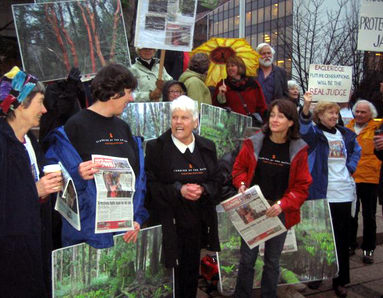
Betty Krawczyk, BC Court, 24 February 2007.
Photo: Eagleridge Bluffs Coalition |
|
A traditional ballad was written to pay tribute to Betty:
Betty's in the Jailhouse Once Again (4mb). The lyrics of another ballad for Betty, by Edith Wallace, read: "And generations yet to come. Will shake their heads at what was done. We're so damn smart and too damn dumb. . . Too blind to see what Betty sees. . . Justice served the Canadian way." Left: many people attended Betty's hearing at the BC Court in Vancouver on 24 February 2007. "People were very angry and upset and there were a lot of tears. There were sustained, powerful 10 minute continuous Shame! Shame, Shame !!! chanting sessions which filled the whole courthouse right up to its soaring glass ceilings. And a large contingent of First Nations women struck up their drums and sang a very beautiful dirge which went on and on, and got everyone singing" Ingmar Lee, CounterPunch, 12 March 2007:
Sentencing of Betty Krawczyk. |
|
| |
|
|
 |
|
| |
The celebrated forest defender returned to the courthouse on 5 March to be given the final verdict (right). Betty's legal counsel, Cameron Ward, bitterly commented on the decision of the unsympathetic judge to jail the 78 year old activist for ten months: "In a way, it's a relief that Ms. Krawczyk was sentenced to merely spend some 300 days in jail; the judge could have imposed any punishment available under the English common law. Theoretically, the judge could have ordered that Betty be hanged at dawn."
The two faced position of the government is clearly exposed by the portrayal of Betty in BC Magazine as a romantic "wilderness heroine" (below). Published to promote tourism, such government propaganda reveals the ever widening split in BC between industrial nature destruction and nature celebrating tourism. Regrettably, the abuse that nature exploitation has inflicted and continues to inflict on the indigenous peoples is not addressed by BC Magazine. |
|
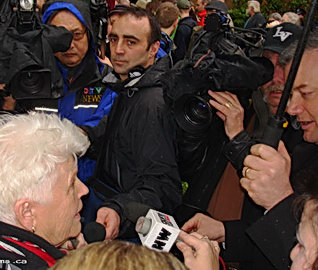
Court hearing, 5 March 2007.
Photo: Jeremy Williams |
|
| |
|
|
 |
|
| |
|
Betty Krawczyk — BC Magazine — Spring 2007 |
|
|
| |
|
|
 |
|
| |

Harriet Nahanee and Betty Krawczyk, 2006.
Eagleridge Bluffs, North Vancouver, British Columbia |
|
On 16 March 2007, from the Alouette Correctional Centre for Women in Maple Ridge, Betty paid tribute to her fallen comrade, Harriet Nahanee, who died unexpectedly on 24 February 2007 following her release from jail: "The air outside is pure and sweet. And free . . . Right now my thoughts are still lingering over Harriet Nahanee's death. Harriet and I, both great grandmothers, knew why we were at Eagleridge Bluffs. Harriet was protesting the negotiating away of unceded Squamish land by the band's chief and council."
"I was protesting the needless destruction of an irreplaceable ecosystem . . . but Harriet's struggle was multifaceted. Harriet's struggle was not only with her own chiefs but with my chiefs too: the West Vancouver police; with the American construction company Kiewit & Sons; with arrest by injunctions; with a history of residential school barbarism. And finally, with the racism of to allow Harriet to even read the Proclamation of 1763 as defense, and instead sent Harriet to the Surrey Pre Trial Prison. May the Grandmothers and Grandfathers take good care of Harriet Nahanee and treat her tenderly." |
|
| |
|
|
 |
|
| |
|
|
| |
©
Credits & Contact |
|
| |
|
|
|
|

